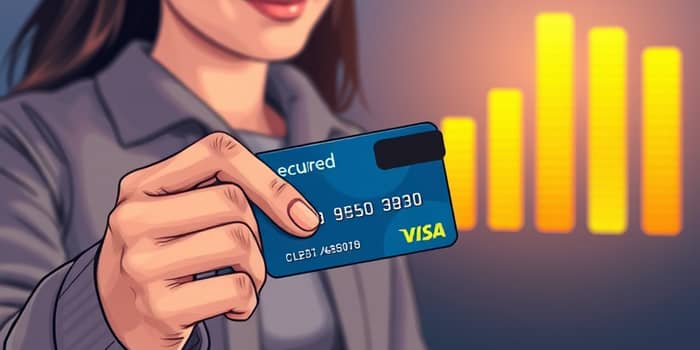Secured credit cards offer a powerful tool for individuals seeking to regain control of their financial lives. By combining practical usage with disciplined repayment, these cards become a stepping stone toward a stronger credit profile. In this article, we explore every aspect of secured credit cards—from basic mechanics to advanced strategies—so you can confidently rebuild your credit history and pave the way for future financial success.
What Are Secured Credit Cards?
A secured credit card is fundamentally different from traditional credit products. It requires a cash deposit, which acts as collateral for the card issuer if payments are missed. That deposit typically becomes your credit limit, ensuring that risk is mitigated for both parties.
For example, a $500 deposit usually corresponds to a $500 credit limit, though some issuers may allow higher limits with additional deposits. You use the card just like any other—making purchases, receiving monthly bills, and paying balances—while the deposit remains safely in reserve.
Why Choose a Secured Card?
Secured cards are designed for individuals with poor, limited, or no credit history. Whether you’re recovering from bankruptcy, missed payments, or you’re a first-time credit seeker, these cards open doors that unsecured products simply won’t.
- Credit-building potential: Monthly payments and usage are reported to all three major credit bureaus, helping to build or rebuild your credit score.
- Stepping-stone to unsecured credit: Responsible use can lead to an upgrade to a traditional credit card with higher limits and better rewards.
- Fraud protection: Enjoy similar security features as unsecured cards, including zero-liability policies and fraud alerts.
Key Differences from Other Card Types
This table highlights why a prepaid card will never help your score, while both secured and unsecured cards report activity to credit agencies. Only secured cards combine collateral with real credit-building power.
Typical Terms and Features
Secured card terms vary, but most share key characteristics:
- Deposit range: Commonly $200–$2,000, though some issuers permit higher amounts to boost limits.
- Refundability: Your deposit is fully refundable upon account closure in good standing or upgrade to an unsecured card.
- Fees and interest: Annual and setup fees can be higher, and interest rates may exceed those of traditional cards if balances are not paid in full.
Understanding these terms up front allows you to choose a secured card with the lowest costs and the most favorable upgrade policies.
How to Use Secured Cards Wisely
Effective usage is essential for credit improvement. Follow these strategies for maximum impact:
- Keep your credit utilization below 30% of your available limit by monitoring spending and making payments promptly.
- Pay in full whenever possible to avoid interest charges and demonstrate responsible credit behavior.
- Set up automatic payments or calendar reminders to ensure on-time settlements each month.
Additionally, monitor your credit report regularly to track progress. Many issuers review accounts after six to twelve months for upgrade eligibility, so staying informed helps you time the transition perfectly.
Timeline and Impact on Your Credit
When used responsibly, secured cards can produce tangible improvements in as little as six months. The combination of on-time payments and low utilization signals positive credit behaviors to scoring models, often resulting in steady score increases.
By the end of a year, many cardholders find they qualify for unsecured credit products with higher limits and added perks. This progress underscores how a temporary secured card can spark permanent credit growth.
Application Process and Upgrading
Applying for a secured card mirrors the unsecured process. You’ll typically submit proof of income, identity verification, and the required deposit. Approval times range from immediate to a few business days.
After demonstrating consistent on-time payments and responsible usage, issuers often offer automatic upgrades to unsecured cards. When this happens, your deposit is returned, and you gain access to better terms and larger credit lines.
Best Practices and Common Pitfalls
To maximize benefits and avoid setbacks, consider these best practices:
- Avoid applying for multiple cards in quick succession to prevent unnecessary credit inquiries.
- Review fee structures carefully and choose cards with reasonable annual costs.
- Keep balances well below your limit, even if you could afford more.
Steering clear of these common errors ensures your journey remains on track and free of avoidable setbacks.
Final Thoughts
Secured credit cards stand out as a reliable, practical solution for those needing to rebuild or establish credit. By combining a refundable deposit with regular reporting to credit bureaus, they offer a clear path to improved scores and financial freedom.
Remember, the key ingredients are discipline and consistency. Make payments on time, maintain low credit utilization, and monitor your progress. Within six to twelve months, you’ll likely find yourself ready to graduate to an unsecured card, leaving past credit challenges behind and opening doors to new opportunities.
Embrace the journey with confidence—your financial future begins with the small steps you take today.
References
- https://www.investopedia.com/terms/s/securedcard.asp
- https://www.debt.org/credit/cards/secured/
- https://www.equifax.com/personal/education/credit-cards/articles/-/learn/what-is-a-secured-credit-card-do-they-build-credit/
- https://bettermoneyhabits.bankofamerica.com/en/credit/build-credit-with-a-secured-credit-card
- https://www.capitalone.com/learn-grow/money-management/how-secured-credit-cards-work/
- https://www.mtb.com/library/article/5-benefits-of-a-secured-credit-card
- https://www.huntington.com/learn/credit-debt/what-is-a-secured-credit-card
- https://www.bmo.com/en-us/main/personal/credit-cards/what-is-a-secured-card/










